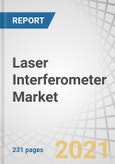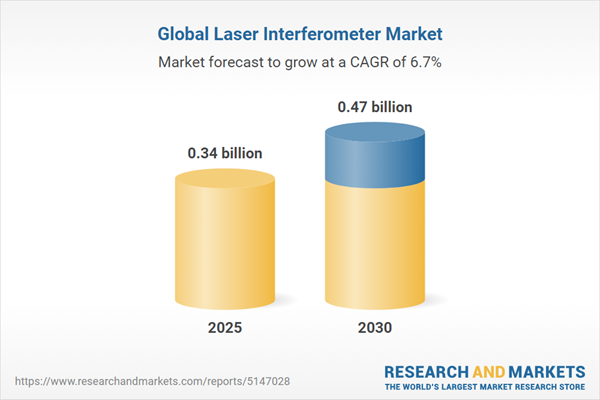The growing trend of semiconductor device miniaturization is significantly boosting the demand for laser interferometers, as shrinking feature sizes to the nanometre scale require precise and reliable metrology tools. Laser interferometers provide sub-nanometre accuracy, enabling semiconductor manufacturers to measure, inspect, and control wafer surfaces for flatness, uniformity, and defects, which are crucial for ensuring device performance. They are equally vital in supporting the development of micro-electromechanical systems (MEMS), where accurate surface topology measurements ensure the reliability of miniature components.
With the semiconductor industry shifting toward advanced packaging techniques such as 3D stacking and system-in-package (SiP), the need for precision alignment and measurement becomes even more critical. Multi-layer device architectures rely on interferometers to verify the thickness, placement, and alignment of each layer, directly impacting efficiency and functionality. Additionally, as new semiconductor materials, processes, and architectures emerge, interferometer manufacturers continuously advance system capabilities, fostering innovation through collaboration with the semiconductor industry. This synergy enables the creation of tailored metrology solutions to meet evolving production challenges. The ability of laser interferometers to deliver non-contact, high-resolution measurements positions them as indispensable tools for ensuring semiconductor quality, driving next-generation electronics development, and fuelling growth in the global laser interferometer market.
Heterodyne segment is likely to contribute a major share of the laser interferometer market from 2025 to 2030.
The heterodyne segment is likely to contribute a major share of the laser interferometer market from 2025 to 2030, owing to its superior measurement accuracy and versatility across diverse applications. Heterodyne interferometers offer high-resolution displacement and velocity measurements, making them invaluable in industries such as aerospace, automotive, semiconductor, and precision engineering. Their ability to minimize phase noise and provide stable, real-time data is especially important in environments requiring ultra-high precision, such as wafer lithography alignment and microelectromechanical systems (MEMS) testing.In manufacturing, heterodyne systems are increasingly used for machine tool calibration, robotic alignment, and dynamic vibration analysis, all of which are critical to ensuring productivity and minimizing operational errors. The growing use of nanotechnology and miniaturized components is also amplifying demand for heterodyne interferometers due to their ability to measure at the sub-nanometre scale. Furthermore, research and academic institutions are expanding their adoption of these systems for advanced optical experiments and material studies. Continuous innovations in laser stability, coupled with the trend toward compact, cost-efficient heterodyne solutions, are further boosting adoption. As industries pursue higher precision, tighter tolerances, and greater automation, heterodyne interferometers are set to remain the dominant choice, solidifying their large market share during the forecast period.
Surface topology application segment is expected to record a significant CAGR in the laser interferometer market from 2025 to 2030.
The surface topology application segment is projected to record a significant CAGR in the laser interferometer market between 2025 and 2030, driven by the rising demand for ultra-precise surface characterization across industries. Surface topology measurement enables manufacturers to detect minute irregularities, roughness, and flatness on critical components, ensuring reliability and compliance with stringent quality standards. In the semiconductor industry, where wafer surfaces must achieve near-perfect flatness, laser interferometers play a crucial role in reducing defects and improving yield rates. Similarly, in optics and photonics, accurate measurement of lens and mirror surfaces ensures optimal performance of imaging systems.Automotive and aerospace manufacturers are also investing in surface topology solutions to validate advanced materials and components used in electric vehicles, aircraft engines, and lightweight structures. With the growing adoption of additive manufacturing and nanotechnology, the need for non-contact, high-resolution, and real-time surface topology inspection is accelerating. Advances in laser stability and digital imaging technologies further enhance the efficiency of these interferometers. The increasing integration of AI-driven analysis for faster defect detection and automation-friendly solutions is also supporting growth. Collectively, these factors position surface topology as one of the fastest-growing application segments in the laser interferometer market over the forecast period.
North America accounted for the largest share of the laser interferometer market in 2024.
North America accounted for the largest share of the laser interferometer market in 2024, supported by its strong base of advanced manufacturing industries, high R&D spending, and widespread adoption of precision measurement technologies. The region’s dominance is largely attributed to its leadership in aerospace, automotive, semiconductor, and healthcare sectors, all of which require high-accuracy inspection and testing tools. U.S.-based semiconductor manufacturers, along with major aerospace companies, have been early adopters of interferometer solutions to meet stringent quality and performance standards.The growing demand for electric vehicles and autonomous driving technologies has further increased the need for laser interferometers in calibration, component testing, and surface topology measurements. Additionally, North America has a robust ecosystem of technology providers and research institutions driving continuous innovation in laser interferometry.
The region also benefits from favourable government support for advanced manufacturing initiatives and increasing investments in metrology and industrial automation. Healthcare applications, including optical diagnostics and ophthalmology, add another dimension to market growth. Furthermore, the presence of global leaders in laser and optical systems in the US strengthens supply capabilities and technological advancements. With its combination of innovation, strong end-user industries, and early adoption trends, North America maintained its lead in the laser interferometer market in 2024.
- By Company Type: Tier 1 - 26%, Tier 2 - 32%, and Tier 3 - 42%
- By Designation: C-level Executives - 40%, Managers - 30%, and Others - 30%
- By Region: North America - 34%, Europe - 25%, Asia Pacific - 30%, and RoW - 11%
Prominent players profiled in this report include Renishaw plc (UK), Keysight Technologies (US), ZEISS Group (Germany), Zygo Corporation (US), and Bruker (US).
Report Coverage
The report defines, describes, and forecasts the laser interferometer market based on type (michelson interferometer, fabry-perot interferometer, fizeau interferometer, mach-zehnder interferometer, sagnac interferometer, twyman-green interferometer), technique (homodyne, heterodyne), application (surface topology, engineering, applied science, biomedical, semiconductor detection), vertical (automotive, aerospace & defense, industrial, healthcare, electronics & semiconductor, telecommunications) and region (North America, Europe, Asia Pacific, RoW). It provides detailed information regarding drivers, restraints, opportunities, and challenges influencing the market growth. It also analyzes competitive developments such as acquisitions, product launches, expansions, and actions carried out by the key players to grow in the market.Reasons to Buy This Report
The report will help the market leaders/new entrants with information on the closest approximations of the revenue for the overall laser interferometer market and the subsegments. The report will help stakeholders understand the competitive landscape and gain more insight to position their business better and plan suitable go-to-market strategies. The report also helps stakeholders understand the market’s pulse and provides information on key drivers, restraints, opportunities, and challenges.The report will provide insights into the following points:
- Analysis of key drivers (Surging demand for precision in manufacturing and quality control, Growing trend of miniaturization of semiconductor devices, Extremely tight tolerances in aerospace & defence and automotive verticals), restraints (High ownership and maintenance costs, Adverse impact of environmental conditions on measurement accuracy, Availability of alternative measurement tools, Risks associated with constant technological upgrades and obsolescence of existing equipment), opportunities (Industrialization in emerging markets, Integration of laser interferometry with automated production lines,
- Product development /Innovation: Detailed insights into upcoming technologies, research & development activities, and new product launches in the laser interferometer market
- Market Development: Comprehensive information about lucrative markets; the report analyses the laser interferometer market across various regions
- Market Diversification: Exhaustive information about new products launched, untapped geographies, recent developments, and investments in the laser interferometer market
- Competitive Assessment: In-depth assessment of market share, growth strategies, and offering of leading players, including Renishaw plc (UK), Keysight Technologies (US), ZEISS Group (Germany), Zygo Corporation (US), Bruker (US), Mahr GmbH (Germany), MÖLLER-WEDEL OPTICAL GMBH (Switzerland), QED Technologies (US), SIOS Meßtechnik GmbH (Germany), in the laser interferometer market.
Table of Contents
Companies Mentioned
- Renishaw plc
- Keysight Technologies
- Zeiss Group
- Zygo Corporation
- Bruker
- Mahr Gmbh
- Möller-Wedel Optical Gmbh
- QED Technologies
- Sios Meßtechnik Gmbh
- Tosei Engineering Corp.
- Automated Precision Inc (Api)
- Pratt and Whitney Measurement Systems, Inc.
- Smaract Gmbh
- Lasertex
- Luna
- 4D Technology Corp.
- Äpre Instruments
- Adloptica Optical Systems Gmbh
- Logitech
- Holmarc Opto-Mechatronics Ltd.
- Attocube Systems Gmbh
- Highfinesse Gmbh
- Xonox Technology Gmbh
- Thorlabs, Inc.
- Lasertec Corporation
- Fujifilm Holdings Corporation
- Olympus Corporation
Table Information
| Report Attribute | Details |
|---|---|
| No. of Pages | 247 |
| Published | October 2025 |
| Forecast Period | 2025 - 2030 |
| Estimated Market Value in 2025 | 0.34 billion |
| Forecasted Market Value by 2030 | 0.47 billion |
| Compound Annual Growth Rate | 6.7% |
| Regions Covered | Global |
| No. of Companies Mentioned | 27 |









